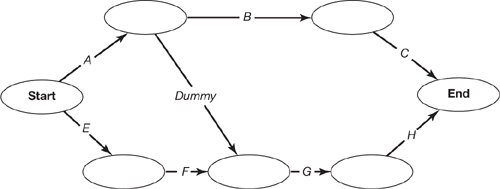Activity sequencing
|
|
The activity sequencing process determines and documents the logical relationship of the activities in the activity list. This enables the activities to be ordered coherently and a project schedule built. The main output from activity sequencing is a network diagram; this is used to show clearly the sequence of work and the dependencies between activities and to estimate the duration of the project. A network diagram can also be used for reporting and controlling project progress. The project manager or a specialized planner can do the sequencing of the project activities. Depending upon the size of the project, this can be done by hand or using specialized project management sequencing software, remembering Hobbes' warning.
Inputs to activity sequencingThere are five inputs to activity sequencing:
Except for the project scope statement, these inputs are created in the activity definition process, discussed above. Tools and techniquesThere are five tools and techniques available for activity sequencing:
Precedence diagramming methodThe precedence diagramming method creates a network diagram (Figure 6.1) where the schedule activities are represented by nodes, or rectangles, and the relationship between the nodes is represented by arrows. There are four types of dependency and precedence relationships that can be shown using network diagrams. These are:
Figure 6.1. Network diagramA network diagram showing the logical sequence for activities. Tasks B, C and D must be carried out sequentially, but can be executed in parallel with tasks F and G. The most commonly used precedent method is the finish-to-start relationship, while the start-to-finish is rarely used. Arrow diagramming methodThe arrow diagramming method, sometimes called the activity-on-arrow method, uses arrows to represent the activities and nodes to represent dependencies. This method uses only a finish-to-start method and uses dummies to enable all logical relationships to be clearly represented (see Figure 6.2). A dummy activity is not a real schedule activity and as such has a zero duration value.
Figure 6.2. Network diagram showing dummy dependencyActivity-on-arrow network diagram. A dummy arrow is used to show logical links between tasks that are dependent upon each other. For example, task A must be complete before task G can start. Schedule network templatesSchedule network templates can be used to accelerate the creation of network diagrams for the project. These can be used for the whole or part of the project and can come from historical data, if similar projects have been performed within the organization before. Dependency determinationDependency determination looks at the dependencies to determine the schedule or aspects of the schedule. There are three types of dependencies:
Applying leads and lagsApplying leads and lags is the last tool and technique for activity sequencing. This technique is applied by the project team once the dependencies have been determined. A lead can quicken a successor activity and a lag will delay one. Activity sequencing outputsThere are four outputs from activity sequencing. The most significant is the project sequence network diagrams. These schematically show the relationship of all the activities required for the completion of the project (e.g. Figures 6.1 and 6.2). The remaining three outputs update the inputs to reflect changes introduced during the activity sequencing process. The complete output list for activity sequencing is:
|
|
Top of Page


